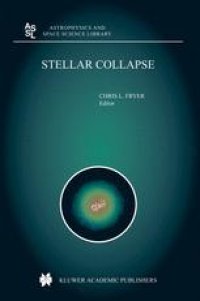
Ebook: Stellar Collapse
- Genre: Physics // Astronomy: Astrophysics
- Tags: Astronomy Observations and Techniques, Astrophysics and Astroparticles, Statistics for Engineering Physics Computer Science Chemistry and Earth Sciences
- Series: Astrophysics and Space Science Library 302
- Year: 2004
- Publisher: Springer Netherlands
- Edition: 1
- Language: English
- pdf
Supernovae, hypernovae and gamma-ray bursts are among the most energetic explosions in the universe. The light from these outbursts is, for a brief time, comparable to billions of stars and can outshine the host galaxy within which the explosions reside. Most of the heavy elements in the universe are formed within these energetic explosions. Surprisingly enough, the collapse of massive stars is the primary source of not just one, but all three of these explosions.
As all of these explosions arise from stellar collapse, to understand one requires an understanding of the others. Stellar Collapse marks the first book to combine discussions of all three phenomena, focusing on the similarities and differences between them. Designed for graduate students and scientists newly entering this field, this book provides a review not only of these explosions, but the detailed physical models used to explain them from the numerical techniques used to model neutrino transport and gamma-ray transport to the detailed nuclear physics behind the evolution of the collapse to the observations that have led to these three classes of explosions.
Supernovae, hypernovae and gamma-ray bursts are among the most energetic explosions in the universe. The light from these outbursts is, for a brief time, comparable to billions of stars and can outshine the host galaxy within which the explosions reside. Most of the heavy elements in the universe are formed within these energetic explosions. Surprisingly enough, the collapse of massive stars is the primary source of not just one, but all three of these explosions.
As all of these explosions arise from stellar collapse, to understand one requires an understanding of the others. Stellar Collapse marks the first book to combine discussions of all three phenomena, focusing on the similarities and differences between them. Designed for graduate students and scientists newly entering this field, this book provides a review not only of these explosions, but the detailed physical models used to explain them from the numerical techniques used to model neutrino transport and gamma-ray transport to the detailed nuclear physics behind the evolution of the collapse to the observations that have led to these three classes of explosions.
Supernovae, hypernovae and gamma-ray bursts are among the most energetic explosions in the universe. The light from these outbursts is, for a brief time, comparable to billions of stars and can outshine the host galaxy within which the explosions reside. Most of the heavy elements in the universe are formed within these energetic explosions. Surprisingly enough, the collapse of massive stars is the primary source of not just one, but all three of these explosions.
As all of these explosions arise from stellar collapse, to understand one requires an understanding of the others. Stellar Collapse marks the first book to combine discussions of all three phenomena, focusing on the similarities and differences between them. Designed for graduate students and scientists newly entering this field, this book provides a review not only of these explosions, but the detailed physical models used to explain them from the numerical techniques used to model neutrino transport and gamma-ray transport to the detailed nuclear physics behind the evolution of the collapse to the observations that have led to these three classes of explosions.
Content:
Front Matter....Pages i-xxxi
Front Matter....Pages 1-4
Massive Star Evolution....Pages 5-38
Review on the Observed and Physical Properties of core Collapse Supernovae....Pages 39-64
Explosion Mechanisms of Massive Stars....Pages 65-97
Neutrino Transport in Core Collapse Supernovae....Pages 99-131
Neutrino-Matter Interaction Rates in Supernovae....Pages 133-174
Protoneutron Star Winds....Pages 175-202
Front Matter....Pages 203-205
Radioactive Decay in Core-Collapse Supernovae....Pages 207-236
Asymmetric Supernova Explosions....Pages 237-258
Magnetic Fields in Supernovae....Pages 259-275
Hypernovae and Other Black-Hole-Forming Supernovae....Pages 277-325
The Collapsar Engine for GRBS and Hypernovae....Pages 327-355
Gamma-Ray Bursts from Supernovae....Pages 357-372
Stellar Collapse and Gravitational Waves....Pages 373-402
Back Matter....Pages 403-411
Supernovae, hypernovae and gamma-ray bursts are among the most energetic explosions in the universe. The light from these outbursts is, for a brief time, comparable to billions of stars and can outshine the host galaxy within which the explosions reside. Most of the heavy elements in the universe are formed within these energetic explosions. Surprisingly enough, the collapse of massive stars is the primary source of not just one, but all three of these explosions.
As all of these explosions arise from stellar collapse, to understand one requires an understanding of the others. Stellar Collapse marks the first book to combine discussions of all three phenomena, focusing on the similarities and differences between them. Designed for graduate students and scientists newly entering this field, this book provides a review not only of these explosions, but the detailed physical models used to explain them from the numerical techniques used to model neutrino transport and gamma-ray transport to the detailed nuclear physics behind the evolution of the collapse to the observations that have led to these three classes of explosions.
Content:
Front Matter....Pages i-xxxi
Front Matter....Pages 1-4
Massive Star Evolution....Pages 5-38
Review on the Observed and Physical Properties of core Collapse Supernovae....Pages 39-64
Explosion Mechanisms of Massive Stars....Pages 65-97
Neutrino Transport in Core Collapse Supernovae....Pages 99-131
Neutrino-Matter Interaction Rates in Supernovae....Pages 133-174
Protoneutron Star Winds....Pages 175-202
Front Matter....Pages 203-205
Radioactive Decay in Core-Collapse Supernovae....Pages 207-236
Asymmetric Supernova Explosions....Pages 237-258
Magnetic Fields in Supernovae....Pages 259-275
Hypernovae and Other Black-Hole-Forming Supernovae....Pages 277-325
The Collapsar Engine for GRBS and Hypernovae....Pages 327-355
Gamma-Ray Bursts from Supernovae....Pages 357-372
Stellar Collapse and Gravitational Waves....Pages 373-402
Back Matter....Pages 403-411
....